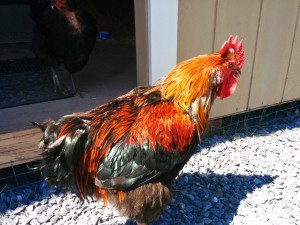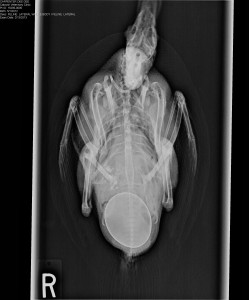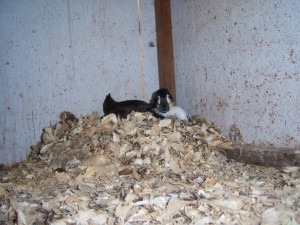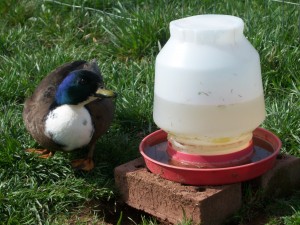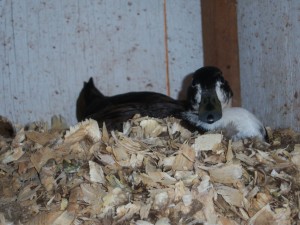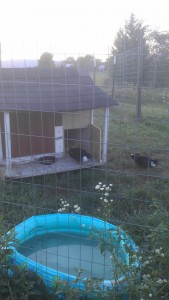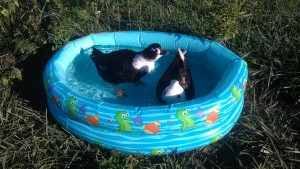Ducks

A new year
0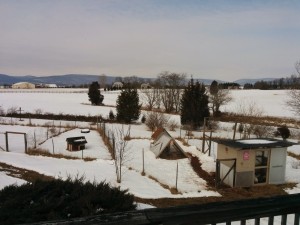 Wow. A whole year has gone by without a post or other update to LLF. Shame on me. I will try to do better this year. The worst part of no updates is that I don’t remember the details of what I planted in the garden and when and what the weather was like and how well the varieties produced. I don’t remember details about the chickens and ducks and my bees.
Wow. A whole year has gone by without a post or other update to LLF. Shame on me. I will try to do better this year. The worst part of no updates is that I don’t remember the details of what I planted in the garden and when and what the weather was like and how well the varieties produced. I don’t remember details about the chickens and ducks and my bees.
I did set up a separate website for a small group of us beekeepers and there was quite a bit of activity on that site. We called ourselves the Honeybee Wranglers and as 2015 progresses we will hopefully build on that information. It has been a long and cold winter just like last year. Maybe not as much snow, but just as long and cold. It is tough for the bees to keep warm and protect the queen and the little bit of brood she may have started producing. So I may not post much about the bees here on the LLF main site, but I will continue to contribute to the Honeybee Wranglers.
In summary, we didn’t do much new with our chickens. We had two chickens die last week. Duran who had some neurological problems in the middle of last year and whom we kept separated from Big Red all fall was found one morning with a very full and hard crop and slumped in the corner of his enclosure. We tended to him in the house for about 24 hours, but he didn’t make it. And then a few days later one of the younger hens was found dead on the floor when we went to open things up in the morning. There was a few other losses over the year. We lost a guinea a few weeks ago – literally lost- as she just disappeared. The guineas can fly out of their yard and perhaps she just got spooked and flew off somewhere and never found her way back. We are down to four now.
We lost a duck to a hawk in early December when we were on a trip to Ohio. Our house sitter called us as we were driving west to give us the news. There were at least two more deaths in the fall. They were only a week or so apart, so I took the second one to the animal health lab for a necropsy and it was determined that she had ILT (Infectious Laryngotracheitis). The state chicken inspector paid us a visit and took cultures (oral swabs) from five birds in each of our three coops. Only the coop where the two chickens died came back positive for ILT, but as a result we were quarantined for two or three months. This means that we take any of our birds off the property during that time. The ban was lifted at the beginning of this year, so we are free to show our championship foul at all the local competitions. Ha ha – not something we do anyway. The virus that causes ILT is a herpes virus and so will be with the birds for life and can be transmitted to other birds. We never saw any of the usual signs of sickness in our flock, but the virus can become life threatening if the birds are ever stressed.

Goodbye ducks, hello chickens
0Last Saturday we went to a chicken swap. We have done this a couple of times before. This one was small and it was a quick trip, but we were meeting someone there to whom we were selling six of our new call ducks. We needed to bring them in a cage which meant that after handing over the six duck and stashing the $50 in my pocket, we had an empty cage and a burning pocket. Maybe you see where I’m going with this. Naturally we couldn’t drive home with an empty cage, so after looking around for 10 minutes we settled on seven new Bantam Cochins. They are not quite full grown but close. They are about half the size of our other chickens. Cochins have very feathery feet and are rather round little things. We bought five hens and were given two roosters.
One of the hens is actually a Belgian D’Uclle. It is a little taller and thinner and has the prettiest Mille Fleur coloring. All the Cochins are supposedly Mille Fleur colored but a couple of them have yet to develop the classic feather tips. I’m not quite sure if that is a regular color for Cochins or if these are crosses of some kind. The two roosters are not Mille Fleur. One is red/brown and the other gray/blue with a brown neck. Coloring may change some as they mature.
We looked longingly at a batch of little quail, but I guess they will have to wait till next year.

Good morning ducks
0The baby ducks are almost full size now. We moved DeeDee next door so Deuce wouldn’t be so lonely, but she continues to be concerned for the babies. The babies are starting to grow into their voices at six-weeks of age, but still no clues that I know about as to which ones are hens and which one drakes. Voice changes occur soon, I think, but changes in plumage won’t show up until around 12 weeks. Very cute, either way.

Ducklings getting bigger
0Wow, are those ducklings growing fast. They are just over four weeks old now and we have to look twice to know who is the momma duck! I think it is almost time to try to reintegrate the Deuce with the family. We’re not sure how that will go, but I guess we’ll find out soon.

An eventful day on the farm
0Yesterday was quite a day here at Little Lucey Farm. (disclaimer: We’re not really a working farm. We just like to play at it.)
Chickens
In the morning the first order of business is to let the dogs out. It looked like we were going to get a beautiful Sunday to work in the yard. I went to the chicken palace and let the birds out and gave them some scratch. We still have two roosters in with the 17 hens and five guineas. The two roosters continue to get along pretty well. Every once in a while there is a little scirmish, but generally they give each other some space. Big Red is clearly the boss rooster, but Duran can hold his own. We have two broody hens: Daisy, who has been in a nest box for at least two week might be ready to give it up soon, and the larger of the two Barred Rocks who has been in a box for about a week. This is a little bit frustrating, because if we had the Maran rooster and hens in the nursery coop like we wanted, then we could give those eggs to one of the broody hens to raise. The ducks had another idea. Maybe in a couple more weeks we can start the process of raising some pure marans birds.
I opened the original coop to let out those 14 hens and Freddie. These are our four year old birds and the one we handled the most and therefore the most friendly. Tilda and Gertie and Gladys are particularly nice hens. These girls are still laying very well. We’re not sure how long they will keep it up, but so far they are doing great.
We had three yards of mulch delivered a couple of days ago and yesterday we continued to weed and clear out some areas so we could spread the mulch. We are having a party next Saturday, so we were working around the deck. We mulched around the new barrel planters and planted some hens and chicks along the cinder block border that leads to the bees. I was also preparing the garden in order to plant the asparagus that we bought. I never got the tiller running this year, so I was doing all the digging by hand. We were just about finished with the mulching in that area when Joni yelled for me to look at the bees. They had just started to swarm!
Bees
I had my phone which was miraculously charged and was able to get some video. We had never seen the swarming process from start to finish. It only took about 15 minutes, but it was pretty cool to watch. They came out of the hive and swirled up and out in front of the hive and formed a large ‘cloud’ of bees. I got some video from several vantage points. It was spectacular. I suppose their landing spot was never in doubt, but I was watching so I would know where they gathered. Naturally, it was the ‘regular’ spot. It was the same small tree and wild raspberry tangle that all five swarms from last year had used. I really should sell little cuttings or seedling of my magic bee-magnet tree. It clearly has magical powers.
I took seven videos. The second one is shown, but you can watch them all if you are interested. They are only a minute or two each:
Video 1
Video 2
Video 3
Video 4
Video 5
Video 6
Video 7
I let them settle for about a half hour and when I went back to the hives, it looked like business as usual. If I hadn’t seen the swarm, I might have never even noticed. The swarm was very quiet. The bees were still settling down and it didn’t look like the scouts were out in large numbers yet. It was also hidden pretty well in the shrubbery. I had to cut away a lot of the brambles to expose the swarm, but once I did that, it looked like it would be an easy operation. With Joni’s help, we cut the branch from the tree and carried it over to the empty hive box already set up and ready for bees. One shake was all it took, and the bees were in the box – and all over the outside as well. I didn’t want to use smoke to get them to retreat into the box because the bees need to spread the queen’s scent to pull the bees in. I was pretty sure the queen was in the box, so I tried to brush the bees away from the top and was able to get an inner cover on the box. In short order, it was clear that bees were heading in through the front entrance, so the job was almost done.
Last year, I think I had a newly installed swarm reswarm after a few weeks, so this time I wanted to be sure the bees had plenty of space. I decided to put a second deep on right away. Another difference from last year is that these boxes already had frames with comb and perhaps even some old honey or almost honey that went through the winter. There is some risk that there could be some wax moths in these frames, so I will keep a close eye out for them. In the meantime, I will take some other frames and put them in the freezer to kill any wax moths that might be hiding. I still have five or six deep frames from my hive #2 that went through the winter with capped honey in them. I thing the best course of action is to try to feed these back to the bees, so I will try a couple of different things toward this end. Today I will simply scratch open one frame of capped honey onto a cookie sheet to see if the bees will go after that. I suspect they will, but if not maybe either the honey is ‘bad’ in some way or maybe they are still foraging (and preferring) the nectar they are finding in the neighborhood.
Ducks
Dee Dee hatched 10 of her 13 eggs two weeks ago and we felt the need to move them to the nursery coop for protection against snakes. So, unfortunately, the nursery coop is being occupied for another couple of weeks. They have really grown and are very cute. Dee Dee is very protective and generally won’t let us near her babies, but yesterday we wanted to see if they would come out of the coop and take their first swim. We filled a tub with water and with a little help all but one made it into the water. Momma let the way. Normally, duck would like to be swimming a lot, certainly a portion of every day, but Dee Dee has been sitting on her nest for a month and now taking care of little ones with not swimming available – until yesterday. It was clear that she was enjoying the bath.
Wildlife
There was a sad moment in the day, too. We knew that a pair of bluebirds had made a nest in a nest box that has been in the yard for several years. We have watched one or two sets of eggs hatch from that box each year. I had seen eggs in the box a few weeks ago and I thought we would take a look to see if the babies had hatched. When we looked in the box we found three tiny dead baby bluebirds. They looked to me to be less than a week old. There was no sign of mommy or daddy bird. Bluebirds are capable of raising young even if one parent dies. Either parent can do the job. This is especially sad and perplexing. Something must have happened to both parents. And two of the eggs or babies were missing as well. We have a snake guard on the pole, so we don’t think it was a snake, but we just don’t know what happened.

Baby ducklings
0The baby ducklings were born this past weekend, 5/10 – 5/11. We had to leave for Delaware in the morning, so we only saw the first four and didn’t really know how many of the 13 eggs would hatch. In fact, I was actually pretty worried that Dee Dee was sitting on too many eggs to be able to hatch them all and therefore thought that it might put them all at risk. Of course, nature knows better, and 10 of the 13 eventually hatched which was a pretty good yield. I guess Dee Dee knew what she was doing.
We kept her separate from Deuce (her boyfriend) and she managed just fine while we were away. Yesterday we moved Dee Dee and her babies into the nursery coop where they are relatively safe from snakes or other predators. They will stay there for several weeks until they are big enough to be safe from hungry snakes. We will probably move them back to the duck area to free up the nursery coop. We still want to breed some Marans this year.

Dee Dee setting
0Our little call ducks did great through the winter. The cold really didn’t seem to bother them. If I broke through the ice on their little pond, they would jump in for a swim. Deuce would almost always be interested in making ducklings and Dee Dee was always willing to participate. Come warmer weather, Dee Dee would often be the one waiting for Deuce. She would jump in the water and stretch her neck out low and long to give Deuce a nice wide, flat landing pad. He would jump on and mate and hop off in just a few seconds.
We were hoping that we would get to see Dee Dee raise some young, but we didn’t know if she would be a good setter. We read that they often are not good at setting or not good at sticking it out for the whole 26-ish days.
A couple of months ago, Dee Dee didn’t come bounding out of her house after Deuce the way she usually did. She came waddling out slowly and lethargically. I know something was wrong. Joni got home from work around 2:00, I think, and examined her. Joni’s first thought was that she was having trouble passing an egg. She hadn’t starting laying, but was about due, so this was a good guess. We headed back to the clinic to see if one of the doctors could tell if she was egg-bound. One x-ray later and it was very clear. She had an enormous egg that she couldn’t pass. After a lot of work the egg was puctured, sucked out, and partially collapsed (using all the proper technical terms, I’m pretty sure :-), the egg was removed and Dee Dee was, once again, a happy quacker.
After that traumatic day, she took a few days off, but then started to lay pretty regularly until she had a nest of about 18 eggs. This seemed like too many to sit on, and as she was not yet showing any signs of setting, we decided to remove all those eggs and let her start again. She and Deuce continued to mate regularly, and she laid another 9 or 10. I was about to start pulling more of those eggs out, when she decided it was time to sit on them (called setting). It has now been about five days into the 26 or so days it takes to hatch ducklings, so time will tell whether or not Dee Dee continues to set and hatch them.

Call ducks
0This weekend we attended the Maryland Poultry Swap & Farmers Market in Sharpsburg. There were lots of chickens, guineas, pheasants, quail, and other animals, but we just couldn’t resist the cute little call ducks. So the farm’s newest residents are Deuce and Dee Dee, a beautiful pair of bibbed call ducks. We set up a fence and a small pool and resurrected the old dog house that was here when we moved in but never used. We thought it would only take an hour or so, but took about half of the day.
The ducks seemed immediately comfortable in their new area and even swam around in their new kiddie/duck pool for a while. They are very attached to each other, quacking frantically even when we picked them up to put them in their reconditioned home for the night. Together, they are really cute. I am looking forward to seeing what kind of eggs they produce and maybe even raising a family in the spring.
